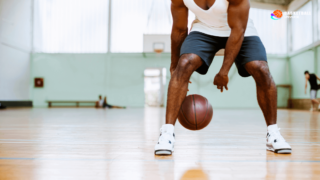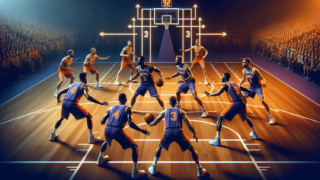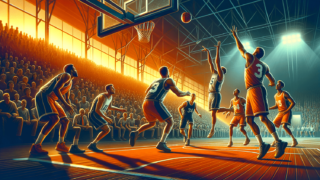
If you’ve ever found yourself glued to a riveting basketball game or participating in a thrilling pick-up match at your local court, you might be curious about the secrets behind an unyielding defense. One such tactic that often flies under the radar is the ever-important ‘Denial Defense.’ This blog post aims to dive into the details of this nifty defensive strategy, ensuring that you not only grasp its mechanics but also master it like a pro. Prepare to unlock the essence of the Denial Defense, as we explore its nuances, variations, and the impact it can have on a basketball game. Get ready, sports fans – it’s time to elevate your defensive prowess!
What’s a Denial Defense in Basketball?
A Denial Defense in basketball refers to a defensive strategy where players aggressively guard their opponents in order to prevent them from receiving the ball or limit their opportunities to create scoring chances. This tactic often involves tight man-to-man coverage, positioning towards the ball side, and maintaining active hands to disrupt passing lanes. The goal of a Denial Defense is to increase pressure on the opposing team, force turnovers, and disrupt their offensive rhythm.
The Fundamentals of Denial Defense
Denial Defense is built on the foundation of strong man-to-man principles. By understanding the basics, you’ll be well-equipped to elevate your defensive game. Let’s dive into the key components that make up this powerful strategy:
Closeout and Pressure
The first thing to master when executing a successful Denial Defense is closing out on your opponent promptly and applying pressure when they receive the ball. Before the pass comes their way, position yourself at arm’s length from your mark and continually make adjustments based on their movements. Upon seeing the incoming pass, make an explosive move towards your mark, arriving just as the ball lands in their hands. Keep a good defensive stance and stay active to keep them off balance.
Ball Denial Positioning
When your opponent does not have the ball, the key to Denial Defense lies in effectively denying them possession. To achieve this, position yourself between the ball handler and your assigned player. Anticipate the opponent’s movements and keep an eye on the ball handler, protecting potential passing lanes. This will make the opposing player think twice about attempting to pass the ball to your mark.
Active Hands and Deflections
Disrupting the opponent’s rhythm is integral to Denial Defense. This is achieved by maintaining active hands, ready to deflect or steal any errant passes. Timing and anticipation are vital here. Train yourself to recognize passing patterns, potential passes, and positioning to place yourself in prime deflection territory.
Communication and Team Chemistry
While individual skills are crucial in executing a Denial Defense, having an entire team that works well together elevates the strategy to another level. Consistent, clear communication is required between teammates, so everyone knows when to switch or cover for one another. Continuously refining your teamwork and chemistry will improve your Denial Defense, making life difficult for the opposing team’s offensive efforts.
Developing Your Denial Defense Skills
Now that you’re acquainted with the fundamentals of Denial Defense, it’s time to focus on skill development. Here are valuable tips and drills to help elevate both individual and team denial capabilities.
Denial Drill 1: Mirror Drill
The Mirror Drill is an excellent way to hone your closeout, pressure, and footwork skills for Denial Defense. The objective of this drill is for the defender to mirror the movements of the offensive player. The offensive player starts with a basketball and moves around the court, occasionally attempting passes, while the defender applies pressure and denies passing lanes. This drill is excellent for improving reaction, agility, and anticipation.
Denial Drill 2: Shell Drill
The Shell Drill reinforces teamwork, communication, and defensive principles within a team setting. Four offensive players are positioned on the court at different spots, while four defensive players align themselves in a Denial Defense setup. Offensive players pass the ball between themselves, while defensive players work to deny passes and force turnovers. A 10-second shot clock can be added to increase the intensity and mimic real-game situations.
Help Side Defense and Rotations
Incorporating help side defense and rotations into your Denial Defense is essential in the evolving nature of a basketball game. When a teammate is beaten off the dribble or requires assistance on their mark, having help ready to step in is key. Defenders must identify gaps, make calculated risks, and be prepared to rotate between opponents as the situation demands.
Scouting and Strategies
To truly refine your Denial Defense, it’s crucial to study the strengths and weaknesses of your team and the opposing team. Recognize mismatches, identify scoring threats, and adapt your defense according to the offensive schemes your opponents employ. By tailoring your defensive approach, you can maximize your chances of success on the basketball court.
Advantages and Consequences of Denial Defense
Understanding the dynamics of Denial Defense allows you to capitalize on its advantages and prepare for potential consequences. Let’s explore these aspects further.
Advantages of Denial Defense
Executing a Denial Defense effectively can yield numerous benefits during a game. These include:
- Increased pressure on the opposing team, leading to turnovers and stolen possessions
- Reduced scoring opportunities and contested shots for your opponents
- Disruption of offensive tactics, plays, and strategies, forcing adjustments
- Allowing your team to dictate the pace and tone of the game by forcing uncomfortable situations
Consequences and Challenges of Denial Defense
While Denial Defense can be a potent tool in a team’s arsenal, it’s not without its challenges and consequences:
- Increased fatigue and wearing on players due to the constant pressure
- Risk of players getting beaten off the dribble or allowing uncontested shots due to overextending, especially against quick and agile opponents
- Potential for foul trouble as players traverse the fine line between aggression and overly physical play
- May leave gaps in help side defense when players are heavily focused on ball denial
Achieving a Balanced Approach and Knowing When to Use Denial Defense
Though the Denial Defense can be a crucial strategy, it’s crucial to recognize that it’s not a one-size-fits-all solution to every situation in basketball. Success depends on striking a balance between aggressive denial and well-rounded team defense. Consider the following factors to decide when to employ this strategy:
- The pace at which both teams are playing: Adjust intensity based on the opposing team’s offensive tempo and your team’s energy levels.
- The style of play: Consider the type of offense your opponents are running; is the Denial Defense well-suited to disrupt their schemes?
- Player matchups: Analyze the strengths and weaknesses of individual players to identify opportunities to utilize Denial Defense effectively.
- Game context and momentum: Evaluate in-game momentum and make tactical adjustments to exploit or neutralize critical moments.
In conclusion, the Denial Defense is an essential building block for any basketball team striving to excel at both ends of the court. By mastering the fundamentals, honing individual skills, and embracing teamwork, you’ll be well on your way to disrupting your opponents’ offensive plans and securing more victories on the court.
Adapting to Modern Basketball with Denial Defense
As basketball continues to evolve, the game has become faster and more offensive-driven. In response, implementing the Denial Defense at key moments is crucial. By addressing the specific nuances of modern basketball, coaches and players can adapt their Denial Defense strategy to maintain a competitive edge on the court.
Defending Beyond the Perimeter
With more teams relying on three-point shooting and perimeter scoring, emphasizing denial defense at and beyond the arc is critical. Train players to align themselves between their opponent and the ball handler on the perimeter, deny inbounds passes, and utilize their wingspan to disrupt passing lanes.
Containing Off-Ball Movement
Off-ball movement is a significant component of modern offenses. Players setting off-ball screens, cutting, and utilizing backdoor plays can catch defenders off guard. By implementing Denial Defense principles in conjunction with off-ball tracking, your team can shut down these scoring opportunities before they materialize.
Applying Denial Defense to Pick-and-Roll Situations
The pick-and-roll is a staple play used by many teams. Incorporate Denial Defense principles by having players fight through screens rather than switch, preventing mismatches and maintaining the original match-up. In doing so, your team can reduce the effectiveness of pick-and-roll plays and retain a defensive edge.
Learning from the Pros: Mastering Denial Defense in Action
Watching and analyzing professional basketball games can provide valuable insights into how a successful Denial Defense strategy works in real-time. Observe elite teams and players that have mastered denial defense in various situations, and learn from their techniques, tactics, and execution.
Studying NBA Defensive Stars
Players like Kawhi Leonard, Draymond Green, and Rudy Gobert are renowned for their defensive prowess. By closely analyzing their defensive strategies, footwork, and in-game adjustments, you can gain a better understanding of Denial Defense principles and their application on the court.
Examining Top NBA Teams
Keep an eye on top defensive teams in the league, such as the Utah Jazz, Los Angeles Lakers, and Milwaukee Bucks. These teams exemplify the perfect synergy between individual defensive skill and excellent teamwork, providing valuable lessons for incorporating Denial Defense principles into your own game.
Enhancing Denial Defense with Physical Conditioning
Executing Denial Defense effectively requires exceptional physical conditioning. With agility, speed, and endurance, you can deny opponents scoring opportunities throughout the game. Here are some physical traits to develop:
Agility
Agility is critical for staying with your opponent and denying them the ball. Incorporate agility drills such as ladder and cone exercises into your workout routine to effectively react to your opponent’s movements and disrupt passing lanes.
Strength
Building your overall strength boosts your ability to withstand the physical demands of Denial Defense. Working on your core, lower body, and upper body strength can give you the power needed to hold your ground, fight through screens, and maintain defensive pressure.
Endurance
Endurance is a must for maintaining Denial Defense throughout an entire game. Interval training and conditioning drills are fundamental to sustaining the high energy levels and focus required for this defensive strategy. Building endurance ensures you’re prepared for those crucial game moments when you need it the most.
By embracing these points, you’ll bring your Denial Defense skills to new heights and be better prepared for present and future basketball challenges. Understanding, practicing, and mastering the Denial Defense can take your game to the next level, boosting your chances for success and an unforgettable in-game experience.
Frequently Asked Questions
As a valuable guide for our readers, we’ve gathered 13 common questions regarding Denial Defense, covering its principles, techniques, and strategies. This FAQ section aims to provide clear and concise answers to help enhance your understanding of this essential defensive tactic.
1. How does Denial Defense differ from other defensive strategies in basketball?
Denial Defense focuses on aggressively preventing opponents from receiving the ball and limiting their offensive opportunities. It emphasizes tight man-to-man coverage, active hands, and positioning towards the ball side to disrupt passing lanes, whereas other defensive strategies may prioritize zone coverage or help-side defense.
2. What are the key components of a successful Denial Defense?
The key components of Denial Defense include closeout and pressure, ball denial positioning, active hands and deflections, and strong communication and team chemistry. These elements work together to effectively disrupt opponents’ offensive plans by denying passes and forcing turnovers.
3. How do I improve my footwork for Denial Defense?
To improve footwork for Denial Defense, focus on agility drills such as ladder and cone exercises, and combine them with defensive slide practice. This training will help enhance your lateral movement, speed, and reaction times, allowing you to stay with your opponent and deny them the ball more effectively.
4. Can Denial Defense be used against different offensive styles?
Yes, Denial Defense can be adapted to defend against various offensive styles. It’s essential to analyze the opposing team’s offensive schemes and adapt your defensive approach accordingly, while maintaining the core principles of Denial Defense.
5. What are some drills to practice Denial Defense?
Some drills to practice Denial Defense are the Mirror Drill, where the defender mirrors the offensive player’s movements and enforces ball denial, and the Shell Drill, which focuses on denying passes and forcing turnovers within a team setting. These drills help develop individual skills and teamwork for a successful Denial Defense.
6. What is help side defense in the context of Denial Defense?
Help side defense refers to the positioning of defenders on the weak side of the court, away from the ball, to provide assistance to their teammates defending the ball handler. Incorporating help side defense principles in conjunction with Denial Defense allows your team to cover potential gaps caused by aggressive ball denial and maintain overall defensive balance.
7. When should I employ Denial Defense during a game?
To optimize Denial Defense effectiveness, consider the game’s pace, style of play, player matchups, and overall momentum. Use this strategy at key moments, such as neutralizing a top scorer, disrupting offensive plays, or forcing turnovers that could influence the outcome of the game.
8. Are there disadvantages or consequences to using Denial Defense?
While Denial Defense has many advantages, it also presents challenges and potential consequences, including increased fatigue, the risk of getting beaten off the dribble, potential foul trouble, and gaps in help side defense. It’s essential to strike a balance between aggressive denial and maintaining overall defensive integrity.
9. How do I maintain energy levels while executing Denial Defense?
Maintaining energy levels for Denial Defense requires building endurance through interval training and conditioning drills. Emphasize proper rest and nutrition for optimal performance. Additionally, coaches should manage player rotations to avoid overexertion throughout the game.
10. Can Denial Defense be used against teams with strong three-point shooters?
Yes, Denial Defense can be employed against teams with strong three-point shooting by adapting your defensive focus, emphasizing tight perimeter coverage, and actively denying ball possession to key shooters. This forces opponents to adjust their offensive schemes and reduces their reliance on outside shooting.
11. What skills should I develop to excel at Denial Defense?
To excel at Denial Defense, develop skills such as anticipation, agility, footwork, lateral quickness, communication, hand-eye coordination, and ball denial positioning. Additionally, improving physical conditioning, including strength and endurance, will further elevate your performance.
12. How do professional NBA teams use Denial Defense?
Professional NBA teams use Denial Defense to apply defensive pressure, neutralize offensive threats, and force turnovers. They study their opponents, identify key matchups, and adjust their approach to exploit weaknesses and maintain a competitive edge on the court.
13. Should I use Denial Defense throughout an entire game?
Using Denial Defense throughout an entire game depends on several factors such as opponent’s offensive style, matchup advantages, and team chemistry. While the strategy may be effective at times, it’s vital to strike a balance between aggressive denial and a well-rounded, adaptable defense to maintain success in various game scenarios.
Featured Posts
- No pillar pages found.




